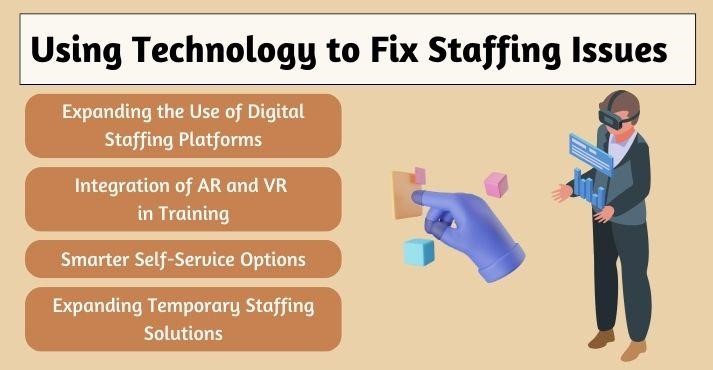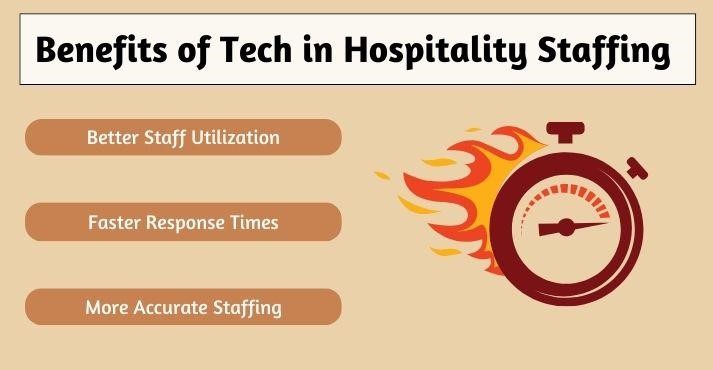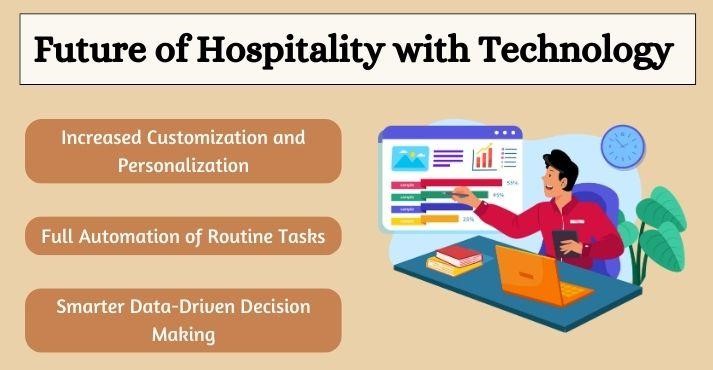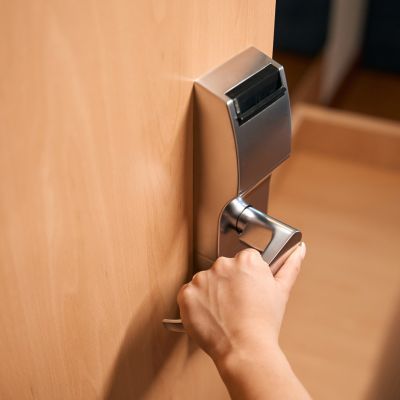The hospitality industry is grappling with a staffing crisis. According to research, the percentage of unfilled jobs in hospitality rose from 35% to 27% due to the pandemic in Singapore alone, and this number continues to rise.
Roles vital to customer service in hotels, restaurants, and bars remain vacant, putting extra pressure on the existing staff.
These businesses rely heavily on employees to offer a welcoming experience to guests, so the need for workers directly impacts the quality of service.
The most promising answer to the hospitality staffing crisis is to use technology. Technology in hospitality staffing provides businesses with new tools, such as AI, self-service kiosks, and digital staffing platforms, to fill staffing gaps and improve efficiency.
This article explores how adopting these technologies is helping hotels, restaurants, and bars overcome staffing shortages and provide better customer experiences.
The Staffing Crisis in Hospitality
The hospitality staffing crisis is a widespread issue affecting various industry sectors, from small local restaurants to large international hotel chains.
The problem has been particularly challenging in the last few years, with high turnover rates, long working hours, and the aftermath of the COVID-19 pandemic making it harder for businesses to keep their workforce.
1. Deeper Look at Staffing Shortages
In the hospitality industry, roles such as waitstaff, front desk agents, and cleaners tend to have high turnover rates.
Employees often leave these jobs after only a few months because of the demanding nature of the work, long hours, and relatively low pay compared to other sectors. As a result, businesses are constantly searching for replacements.
Moreover, the COVID-19 pandemic changed the labor market, as many workers left the industry and never returned. Many people found jobs in other industries with more flexible working conditions or remote opportunities, making it even more difficult for hospitality businesses to recruit staff.
2. Effects on Business Performance
The ongoing shortage of workers has had several adverse effects on the performance of hospitality businesses:
- Overworked staff: The remaining staff are often required to take on more duties to compensate for the shortage of workers, which can lead to burnout.
- Customer service issues: With fewer employees, businesses need to maintain the same level of service, resulting in longer wait times, mistakes in orders, or poor guest experiences.
- Lost revenue: In some cases, businesses have had to limit their services or reduce operating hours because they don’t have enough staff to run at total capacity, which means lost revenue opportunities.
Many businesses are turning to hospitality staffing technology to address these food service challenges and improve the situation.
Role of Technology in Solving Staffing Issues

The hospitality industry has long been challenged with staffing shortages, particularly in roles that experience high turnover, such as housekeeping, waitstaff, and front desk agents.
However, technological advancements have provided businesses a valuable tool to manage these shortages more effectively.
Adopting digital staffing platforms, automation, and virtual reality training has transformed how hospitality businesses recruit, manage, and train their employees.
These tools address the immediate staffing crisis and offer long-term solutions that increase overall operational efficiency.
1. Expanding the Use of Digital Staffing Platforms
Digital staffing platforms like Qwick have proven highly effective in helping hospitality businesses overcome staffing shortages. These platforms allow businesses to quickly hire temporary staff to fill shifts when full-time employees are unavailable.
They offer an immediate solution to fluctuating staffing needs, making managing periods of high demand easier without the lengthy and often costly traditional hiring process.
“I expect to see more hospitality businesses adopt technology to solve the issue of staffing. Specifically, many more will utilize it as a permanent and trustworthy solution to fill recurring shifts instead of continuing traditional, permanent hiring for roles known for high turnover.”
Leah Tsonis, Senior Manager of Content Marketing at Qwick
Leah’s insight highlights a shift in how businesses view staffing.
Temporary solutions are increasingly seen as a stopgap and a reliable, long-term strategy to handle labor shortages in hotels.
Here’s how digital staffing platforms work:
- Instant matching: Platforms match businesses with temporary workers who are available and qualified for the job. This reduces the time spent searching for candidates and ensures that shifts are filled promptly.
- Flexibility: Businesses can hire staff for a few hours, a single shift, or longer-term assignments based on their needs. This flexibility is crucial for industries like hospitality, where demand can fluctuate dramatically.
- Reduced hiring costs: Traditional hiring processes, including posting job ads, conducting interviews, and onboarding, are time-consuming and costly. Digital staffing platforms streamline this process by providing access to a large pool of pre-vetted candidates, saving time and money.
- Automation could manage cleaning schedules, room service deliveries, and restaurant food preparation. This would further reduce the need for additional staff while maintaining high service standards.
For example, at Hilton, AI-powered robots already serve as hotel concierges and enhance the employee experience.
2. Integration of Augmented Reality (AR) and Virtual Reality (VR) in Training
AR and VR could be more significant in hospitality training as technology evolves. These tools can create immersive training experiences for staff, allowing them to practice real-world scenarios without on-site instructors. For example:
- Virtual reality training for hotel staff could simulate check-in procedures, room service tasks, or handling guest complaints. This allows new employees to learn without the pressure of real-world consequences, speeding up their training and making them more comfortable when they start the job.
- Augmented reality can be used in kitchens to provide real-time guidance for chefs. It can show them how to prepare complex dishes or follow detailed recipes, reducing errors and improving food quality.
3. Smarter Self-Service Options
As self-service technology develops, hotels and restaurants can expect more sophisticated self-service kiosks and mobile ordering systems.
These systems will allow guests to check in, order food, and make payments, and they could also integrate with customer preferences and loyalty programs.
- Mart kiosks could recognize repeat guests and offer personalized room upgrades, dining recommendations, or special deals based on previous visits.
- Mobile apps allow hotel guests to control room features like lighting, temperature, and entertainment systems, reducing the need for on-site staff assistance.
This automation in hotels will make the guest experience more efficient while reducing the burden on staff.
4. Expanding Temporary Staffing Solutions
Temporary staffing platforms like Qwick will likely grow in popularity, providing hospitality businesses with an even larger pool of qualified workers. These platforms may also integrate additional features, such as:
- Predictive staffing models, where AI analyzes historical data to forecast peak business times and suggest the optimal number of staff needed.
- Skill matching algorithms to ensure that the temporary staff hired are well-suited for specific roles, reducing training time and improving service quality.
As digital staffing platforms evolve, they will become an essential tool for hospitality businesses looking to manage their workforce more effectively and flexibly.
Benefits of Technology in Hospitality Staffing

Technology helps hospitality businesses solve staffing issues and provides long-term benefits that improve operations, staff satisfaction, and customer experiences.
1. Better Staff Utilization
With AI and automation, businesses can make better use of their available staff. Instead of employees being tied up with repetitive tasks, such as answering the same guest inquiries or manually processing orders, these tasks can be automated. This means:
- Staff can focus on higher-value interactions with guests, such as providing personalized service, solving complex problems, or enhancing the guest experience.
- Managers can use restaurant scheduling software to better allocate staff based on demand, ensuring that employees are well-rested during peak hours or idle during slow periods.
Businesses can improve employee satisfaction and customer service by utilizing staff more effectively.
2. Faster Response Times
With AI-powered chatbots and self-service kiosks, hospitality businesses can provide guests with instant responses to their questions and needs. This reduces wait times and ensures customers receive the information or service they need immediately.
- Chatbots can instantly answer common questions like “What time is check-out?” or “Is there a swimming pool?” Guests don’t have to wait for a staff member to be available, which improves their overall experience.
- Self-service kiosks in restaurants or hotels allow guests to place orders, check-in, or make payments quickly and easily, reducing queues and enhancing convenience.
3. More Accurate Staffing
Using AI and digital staffing platforms, hospitality businesses can take a data-driven approach to hiring and scheduling. For example:
- AI tools can analyze past business data to predict busy periods, helping managers decide when to bring in temporary staff or adjust work schedules.
- Digital staffing platforms can instantly match businesses with temporary workers, reducing the time and effort spent searching for new hires.
This results in more accurate staffing, ensuring that there are always enough employees to provide excellent service without the risk of overstaffing during slow periods.
Challenges and Considerations
1. Addressing the Cost of Technology Adoption
While hospitality staffing technology offers many benefits, there’s no denying that the upfront costs can be significant, especially for smaller businesses.
Installing self-service kiosks, adopting AI-powered systems, or using advanced scheduling software requires an initial investment, and not all businesses are prepared for that expense.
To overcome this challenge, businesses can:
- Look for scalable solutions that allow them to adopt technology gradually, starting with one or two self-service kiosks before expanding.
- To reduce the upfront costs, explore leasing options for equipment like kiosks or robots rather than purchasing them outright.
- Take advantage of trial periods offered by digital staffing platforms or AI tools to see if the technology fits before committing to a long-term contract.
2. Training and Transition
Introducing new technology also means businesses must train their staff to use these tools effectively. Transitioning from traditional staffing methods to technology-driven solutions may take time, and some employees may need to change.
To ease this transition:
- Businesses can provide comprehensive training programs to help staff become comfortable with new technologies, such as AI chatbots, restaurant scheduling software, or self-service kiosks.
- Managers can involve employees in the technology adoption process by gathering feedback and addressing concerns about how the new tools will impact their roles.
- Businesses can incentivize staff who successfully integrate technology into their daily tasks, making the transition smoother and more positive.
Future of Hospitality with Technology

The continued integration of AI, automation, and digital staffing platforms will drive the future of the hospitality industry. Here are some additional trends and predictions for how hospitality staffing technology will shape the industry:
1. Increased Customization and Personalization
As technology becomes more sophisticated, we expect to see a greater focus on personalization. AI tools can analyze guest preferences and create more personalized experiences. For example:
- Hotels could use AI to recommend specific rooms, activities, or dining options based on a guest’s previous visits.
- Restaurants could use mobile ordering systems to suggest meals based on customers’ past orders or dietary preferences.
2. Full Automation of Routine Tasks
In the future, routine tasks like check-ins, cleaning, and food preparation may be fully automated. For example:
- Automated kitchens could handle food service and preparation from start to finish, reducing the need for kitchen staff and ensuring consistency in meal quality.
- Automated check-ins using self-service kiosks could become the norm in hotels, allowing guests to enter their rooms without interacting with a staff member.
3. Smarter Data-Driven Decision Making
With the help of AI and data analytics, hospitality businesses will have access to more detailed insights about their operations. This will allow them to make more competent staffing, guest services, and resource allocation decisions.
For example:
- AI-powered tools analyze guest feedback and operational data to identify areas for improvement, such as optimizing staffing during busy periods or improving service delivery in specific areas of the business.
- Predictive analytics could help businesses forecast future demand more accurately, allowing them to plan for staffing needs well.
Conclusion
The use of technology to solve the hospitality staffing crisis is transforming the industry. With tools like digital staffing platforms, AI, self-service kiosks, and automation, businesses are finding innovative ways to address labor shortages while maintaining high service levels.
While there are challenges, such as the initial cost of adoption and the need for training, the long-term benefits far outweigh these hurdles.
As technology evolves, hospitality businesses can operate more efficiently, provide better customer experiences, and remain competitive in an ever-changing industry.
The future of hospitality staffing is undoubtedly intertwined with technology, and businesses that adopt these innovations will be well-positioned to succeed.











